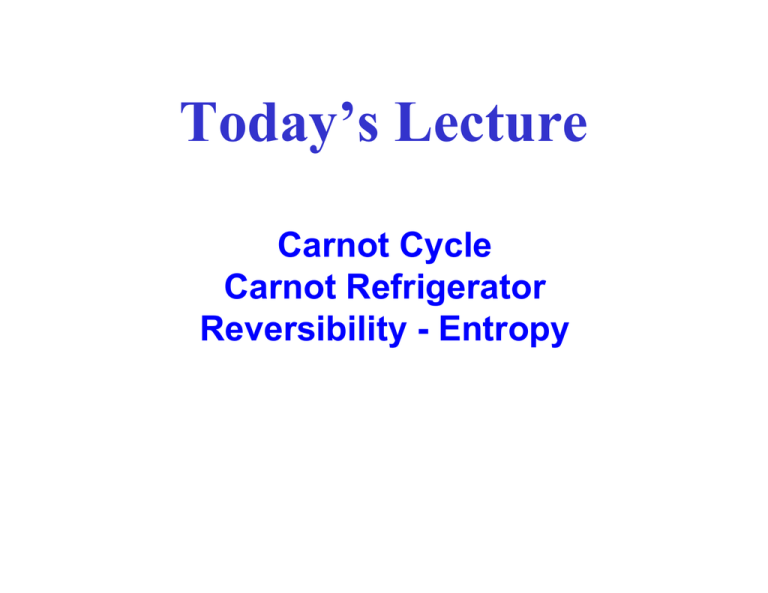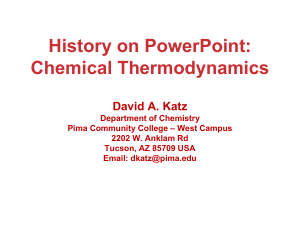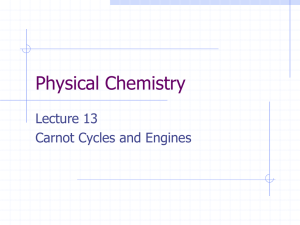Today’s Lecture Carnot Cycle Carnot Refrigerator Reversibility - Entropy
advertisement

Today’s Lecture Carnot Cycle Carnot Refrigerator Reversibility - Entropy What is the net work and efficiency of a Carnot cycle? Carnot Cycle Wtotal = WAB + WCD A B D C Since ThVBγ−1=TcVCγ-1 and ThVAγ-1=TcVDγ-1 Qc Tc = Qh Th We have VB / VA = VC / VD and Efficiency W Qh − Qc Th − Tc = = e= Qh Qh Th Carnot Cycle Efficiency W Qh − Qc Th − Tc e= = = Qh Qh Th Irreversible engines are necessarily less efficient, but so are many reversible engines! In a Carnot cycle all of the heat exchange takes place only between the highest and lowest temperatures, hence the Carnot cycle is the most efficient cycle. Carnot Cycle Efficiency W Qh − Qc Th − Tc = = e= Qh Qh Th • For highest efficiency we would want to run our engine between a very hot and a very cold reservoirs. • Large temperature difference, Th-Tc, and low temperature of the cold reservoir, Tc, are very helpful. • Efficiency can in principle reach 100% for Tc = 0, but we normally do not have such reservoirs available… Example: Carnot Cycle During a Carnot cycle the isothermal expansion takes place at 227oC while taking in 1500J from the hot reservoir. The isothermal compression takes place at 27oC. (a) What is the energy expelled to the cold reservoir? (b) What is the net work done by the gas during each cycle? (c) What is the efficiency of this cycle? Adiabatic, Isothermal Cyclic Process Versus Carnot We have already examined this cyclic process ABCA. This time we will examine it with some care in the reverse order, ACBA. Assume that the initial conditions, VA, PA, and TA are known as well as the compressed volume VB=VC. The temperature at B is found from the adiabatic expansion to A. The work done and heat absorbed by the gas during the adiabatic expansion from B to A are: The work done and heat absorbed by the gas during the isothermal compression from A to C are: Adiabatic, Isothermal Cyclic Process Versus Carnot We have already examined this cyclic process ABCA. This time we will examine it with some care in the reverse order, ACBA. Assume that the initial conditions, VA, PA, and TA are known as well as the compressed volume VB=VC. The work done and heat absorbed by the gas during the isochoric process from C to B are: The net work done and net heat absorbed by the gas during one cycle are: They are equal. Why?? Adiabatic, Isothermal Cyclic Process Versus Carnot Finally what is the efficiency of this cycle versus a Carnot cycle? The efficiency of this cycle is: The efficiency of a Carnot cycle is: For a volume ratio of 4:1 and γ = 1.4 these efficiencies are: We see that the Carnot cycle represents ~ 70% improvement! Stirling Engine A Stirling engine is based on a fixed amount of gas in a sealed engine with a hot and cold reservoir. There are two cylinders one is heated by an external heat source while the other is cooled (radiator etc.) The Stirling engine comes as close to following the Carnot cycle as is practically possible. http://www.keveney.com/Vstirling.html Since it can run on any source of heat, it holds promise for alternative fuel engines (burning garbage), solar heating (no exhaust), geothermal, etc. Demonstration of a Stirling Engine. Stirling Engine In a Stirling cycle there are two isothermal processes and two isochoric processes. (a) Find the net work done by n moles of an inert gas during this cycle. (b) Find the efficiency of this cycle. (c) Compare this efficiency to that of a Carnot cycle. (a) The only work is performed during the isothermal processes. (b) To find the efficiency we need to determine the heat input. Stirling Engine In a Stirling cycle there are two isothermal processes and two isochoric processes. (a) Find the net work done by n moles of an inert gas during this cycle. (b) Find the efficiency of this cycle. (c) Compare this efficiency to that of a Carnot cycle. (b) The efficiency is Wnet / Qin: (c) The Carnot efficiency is: Carnot Refrigerator Isothermal contraction adiabatic expansion adiabatic contraction Isothermal expansion The key part is the isothermal process DC – the only time the system is in contact with the cold reservoir. The gas is made to expand taking heat Qc from the cold reservoir. Isothermal contraction adiabatic expansion adiabatic contraction Isothermal expansion Inverting the cycle - building a refrigerator Mind the conventions: Qh is positive when obtained from the Hot Res.; Qc is positive, when rejected to the Cold Res.; W is positive, when done by the gas… Now we have: Qh< 0, Qc< 0, W< 0. W = Qh − Qc Qc = Qh − W Qc Tc = Qh Th Refrigerators Coefficient of performance, COP Qc Qc COP = = W Qh − Qc Inverting the cycle building a refrigerator For a Carnot cycle Tc COP = Th − Tc COP goes to 0, when Th goes to infinity; COP is equal to 1, when Th = 2⋅Tc; COP becomes infinitely large as Th approaches Tc! Example: Carnot Refrigerator A home freezer, working between -18°C inside and 30°C outside has Inverting the cycle building a refrigerator How much electrical energy is required to cool 0.53 kg of water by 1°C? How much heat will be rejected to the air in the kitchen? For a Carnot cycle Tc COP = Th − Tc What is the ratio between the work done by the motor in a heat pump and heat transferred to the house? Qh Qc + W = = COP + 1 W W For 25°C inside the house and 10°C found 2m under the ground COP = 19 Carnot’s Theorem No engine operating between temperature baths with temperatures Th and Tc can have an efficiency greater than the Carnot efficiency, e=(Th-Tc)/Th. To prove this theorem consider a Carnot refrigerator We could design a Carnot refrigerator in which each process runs in reverse using the same temperature baths. If we then had an superefficient engine operating between the same two temperature baths with a greater efficiency than the Carnot efficiency, we could use it in conjunction with a Carnot refrigerator to extract work from the hot reservoir without transferring any heat to the cool reservoir! Carnot’s Theorem No engine operating between temperature baths with temperatures Th and Tc can have an efficiency greater than the Carnot efficiency, e=(Th-Tc)/Th. The superefficient engine extracts energy Qh + Δ from the high temperature reservoir and emits energy Qc to the low temperature reservoir. In conjunction a Carnot refrigerator operates between the same two temperatures. The net effect is to extract energy, Δ, from a high temperature reservoir and perform an equal amount of work. This is in violation of the second law of thermodynamics! Carnot’s Theorem No engine operating between temperature baths with temperatures Th and Tc can have an efficiency greater than the Carnot efficiency, e=(Th-Tc)/Th. Consider the example of a superefficient (70%) Carnot engine acting as a Carnot refrigerator (when e=(Th-Tc)/Th =.6) reversed so it acts as a refrigerator and a 60% efficient Carnot engine. This again violates the 2nd law of thermodynamics. We could make the same argument for any Carnot engine operating between two temperature baths. Remember: Since all of the heat exchange takes place only between the highest and lowest temperatures, the Carnot cycle is the most efficient cycle, Reversibility Where do we find reversible processes? In mechanics – • elastic collisions; • oscillations with no friction; http://www.myphysicslab.com/pendulum1.html • rotation of planets. . . No mechanical energy is dissipated into heat-internal energy! You can run the movie backwards and it will still be a plausible process. For example a Carnot engine and a Carnot refrigerator. Irreversibility Where do we find irreversible processes?... Pretty much everywhere, damn it!.. And we are not getting any younger either!.. You can’t possibly run that movie back… Losing, breaking, destroying, saying stupid things…. Seriously. Three common scenarios of irreversibility in thermodynamics. 1) Mixing and loosing structural order in general. Two molecularly mixed fluids never “unmix”. http://mutuslab.cs.uwindsor.ca/schurko/animations/irreversibility/happy.htm A broken vase never repairs itself… 2) Conversion of mechanical energy into internal energy (dissipation into heat). Ordered motion of an object is converted into disordered motion of its molecules. Never coming back… http://mutuslab.cs.uwindsor.ca/schurko/animations/secondlaw/bounce.htm 3) Heat transfer from a hotter to a cooler object – never goes in the opposite direction. Irreversibly lost opportunities... #1 Expanding gas… On the way from a to b the gas could be harnessed to do some mechanical work at expense of its internal energy… W = −ΔU Q=0 Instead of that we have W =0 Maxwell’s demon ΔU = 0 #2 Two systems with different temperatures reaching equilibrium… There was an opportunity for a spontaneous process – heat flow from Th to Tc. It could be used to run a heat engine between the two reservoirs (hot and cold). Maxwell’s demon: high speed molecules go to the right, low speed – to the left. Maxwell distribution after thermal equilibrium is established… Order is lost! There is no way the molecules would spontaneously break into two groups – with high and low temperatures. Entropy Entropy provides a quantitative measure of disorder. Consider the isothermal expansion of an ideal gas. If we add heat dQ and let the gas expand just enough to keep the temperature constant, then from the first law: The gas becomes more disordered because there is a larger volume and hence more randomness in the position of the molecules. We define the infinitesimal entropy change dS during an infinitesimal process as: For an isothermal process the change in entropy is ΔS = Q/T. Higher temperature implies greater randomness of motion. If the substance is initially cold then adding heat causes a substantial fractional increase in molecular motion (and randomness). But if the substance is already hot then adding the same quantity heat adds relatively little molecular motion that what was already present. Hence Q/T characterizes the increase in randomness (or disorder) when heat flows into a system. Entropy Consider the Carnot Cycle where we found If we change the definition of Qc so that it is the heat added vs heat rejected then Any closed reversible cycle can be made up of incrementally small isothermal and adiabatic cycles. This leads to This means that the integral representing the change in entropy, is path independent! Entropy If we take a system around a path that is not closed then its entropy does change. Since the change in ΔS is path independent, entropy is a state property, like temperature, and is independent of the path between state 1 and state 2. Consider mixing 1kg of 0oC with 1kg of 100oC water, an irreversible process. Assume two reversible processes, slowly heating the cold water to 50oC while slowly cooling the hot water to 50oC. This example is an irreversible processes. However entropy is a state property which is independent of how you got to that state. Hence the results were obtained by reaching the final states via reversible processes. Entropy This definition of entropy is only meaningful for reversible processes. An irreversible process takes a system out of equilibrium, this means that T may not be well defined. But entropy is a state variable, it doesn’t care how you got to a certain state only what the state is! Consider adiabatic free expansion, an irreversible process, where the gas is discharged into a vacuum chamber. Neither the temperature nor internal energy of the gas changes. From the ideal gas law in an isothermal expansion: The energy that became unavailable to do work is: Both of these examples were irreversible processes. Remember entropy is a state property and as such is independent of how you get to that state. Hence the results were obtained by reaching the final states via reversible processes. Entropy The examples on the previous slide described systems that evolved into systems of higher disorder. In free expansion and coming to thermal equilibrium, the ability to do work was lost as the systems evolved into states of higher disorder. The mixing of colored ink starts from a state of relative order to a state that is more disordered. A state of higher entropy. Spontaneous unmixing, a net decrease in entropy, is never observed! In general, “When all systems taking part are included, the change in entropy is greater than or equal to zero”. Entropy In general, “When all systems taking part are included, the change in entropy is greater than or equal to zero”. As an example consider 4 coins that lie on a table in random orientations. There is only 1 way that they have either 4 heads or 4 tails. These are the orientations of highest order. There are 4 ways that they have either 3 heads and 1 tail or 3 tails and 1 head. These are the orientations of next highest order. Finally there are 6 ways in which there are 2 heads and 2 tails. This is the state of highest disorder! For any system, the most probable state is the one with the greatest number of corresponding microscopic states, which is also the macroscopic state with the greatest disorder and largest entropy! Summary of the Second law of Thermodynamics Cyclic processes: Second Law of Thermodynamics: It is impossible to construct a heat engine that extracts heat from a reservoir and delivers an equal amount of heat. Irreversible processes decrease the organization of a system. This is due to statistical reasons. Efficiency of a reversible heat engine is Entropy measures the relative disorder of a system and corresponds to decreasing energy quality. The entropy difference between two states is This integral may be done assuming reversible processes as entropy is a state variable!








